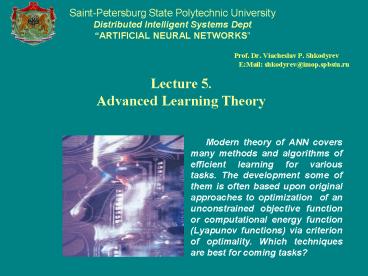Lecture 5. Advanced Learning Theory - PowerPoint PPT Presentation
1 / 16
Title:
Lecture 5. Advanced Learning Theory
Description:
The development some of them is often based upon original approaches to ... Russel S, Norvia P. Artificial Intelligence. [Page 619] ... – PowerPoint PPT presentation
Number of Views:49
Avg rating:3.0/5.0
Title: Lecture 5. Advanced Learning Theory
1
Lecture 5. Advanced Learning Theory
Saint-Petersburg State Polytechnic
University Distributed Intelligent Systems
Dept ARTIFICIAL NEURAL NETWORKS
- Prof. Dr. Viacheslav P. Shkodyrev
- EMail shkodyrev_at_imop.spbstu.ru
Modern theory of ANN covers many methods
and algorithms of efficient learning for various
tasks. The development some of them is often
based upon original approaches to optimization
of an unconstrained objective function or
computational energy function (Lyapunov
functions) via criterion of optimality. Which
techniques are best for coming tasks?
2
Optimization techniques are ubiquitous in
the field of NN. Solution of the optimization
tasks is one of the widest science area in
mathematical system theory. Nevertheless, it is
very important to make right selection of correct
solution of this task. In this lecture we
acquaintance with some interesting approaches and
techniques..
- Objective of Lecture 5
- The main objective of this lecture is to
discuss popular learning technique which can be
most useful for different tasks Genetic
Algorithm. Lecture acquaintance you with
theoretical backgrounds of GA and some
computational technique of learning algorithms.
We will analyze - Modern tendency of Neural Network learning
theory - Introduction to Genetic Algorithms of ANN
- Computation models of NN learning
3
Genetic Algorithms
4
Global Strategies in optimal tasks solution
Two strategies of Task Solution 1 - exhaustive
searching or simple sorting of variants without
modifications of algorithms 2 evaluation
selection of the best solutions and their
reproducing.
Evolution selection
Exhaustive searching
5
Exhaustive Searching of Optimum
Parallel Searching of Optimum
6
(No Transcript)
7
GAs are stochastic optimization methods that
imitate a biological evolution strategy. They
realize a sequences process of evolution
development of optimization as reproduction and
selection the best individuals e.g. models,
solutions, systems, in a full population of them.
During this process the individuals are compare
with the help of a (previously defined) fitness
function. Successive individuals are emphasized
and selected for further use, while insuccessive
ones will rather be eliminated from the
population and from future reproduction.
The key question is how to allocate the
searching resources
Evolution selection
It can be shown that, under certain assumption,
the GA allocates resources in an optimal way
Goldberg,1989.
?
8
With GA we simulate an evolution process of a
best solutions searching as a symbolic
optimization by chromosomes changing. We define
9
1. Coding of individuals in GA We want to
formalize the feature of individuals
One of the first step in GA consists in
coding of the features of preliminary selected
solutions which form an initial population of
individuals.
We will understand under individuals the
full number of variants of solutions, which is
coding by hromosoma model.
But how to realize a hromosoma model
10
(No Transcript)
11
2. The Selection strategy
SS is direct searching in the space of
individuals one that maximizes the fitness
function. Important the search is parallel
because each individual in the population can be
seen as a separate search.
12
At first, the existing individuals of a
population are treated as suboptimal solutions,
and their actual state is coded with the help of
a string of chromosomes.
GA reproduction of a new generation of
individuals, change by a, b crossover, c
mutation. The optimization of a full population
instead of a single individual leads to an
occupation of several local maxima of the
fitness function.
Reproduction of a new generation
Initial population
Fitness Function
New population
Selection
Best solution
GA starts with a set of one ore more
individuals and applies selection and
reproduction operators to evolve (????????) an
individuals that is successful, as measured by a
fitness function.
?
In the case of temporally changing states of the
plant or process situation, the GA can find the
(new) absolute maximum very quickly since good
starting points are already at hand.
13
Cross-over Is a model of reproduction when
all the individuals that have been selected for
reproduction are randomly paire, and then for
each pair a cross-over point is randomly chosen.
After cross-overing reproduction one offspring
will get a part of genes (before cross-over
point) from the first parent, and the rest from
the second parent.
Mutation Is a variant of reproduction
model where each gene can be altered by random
mutation to a different value, with small
independent probability.
Inversion Is a modified mutation when a
part of chromosome change his ordering on
opposite.
14
Symbolic optimization by chromosomes changing
Fitness Function
Reproduction of a new generation
Selection
The population of binary strings which represent
potential solutions
15
Conclusion. Thus, one can state that
also evolutionary mechanisms underlie an
evolutionary process, and those which are still
existing after many generations are supposed to
be very good with respect to the fitness
functions involved. Whereas GAs have a
guaranteed convergence and are easy to
implement, there is no guarantee to find the
optimum solution, and the high amount of
individuals to be processed can make the
algorithm relatively time consuming.
16
- The books.
- Goldberg D.E. Genetic Algorithm in Search,
Optimization and Machine Learning. . - Russel S, Norvia P. Artificial Intelligence.
Page 619. - Cichocki A. Unbehauen R. Neural Networks for
Optimization and Signal Processing, Wiley, 1993. - WWW-sites
- http//www.aic.nrl.navy.mil/galist
- http//www4.ncsu.edu/eos/users/d/dhloughl/public/g
a_background.htm































